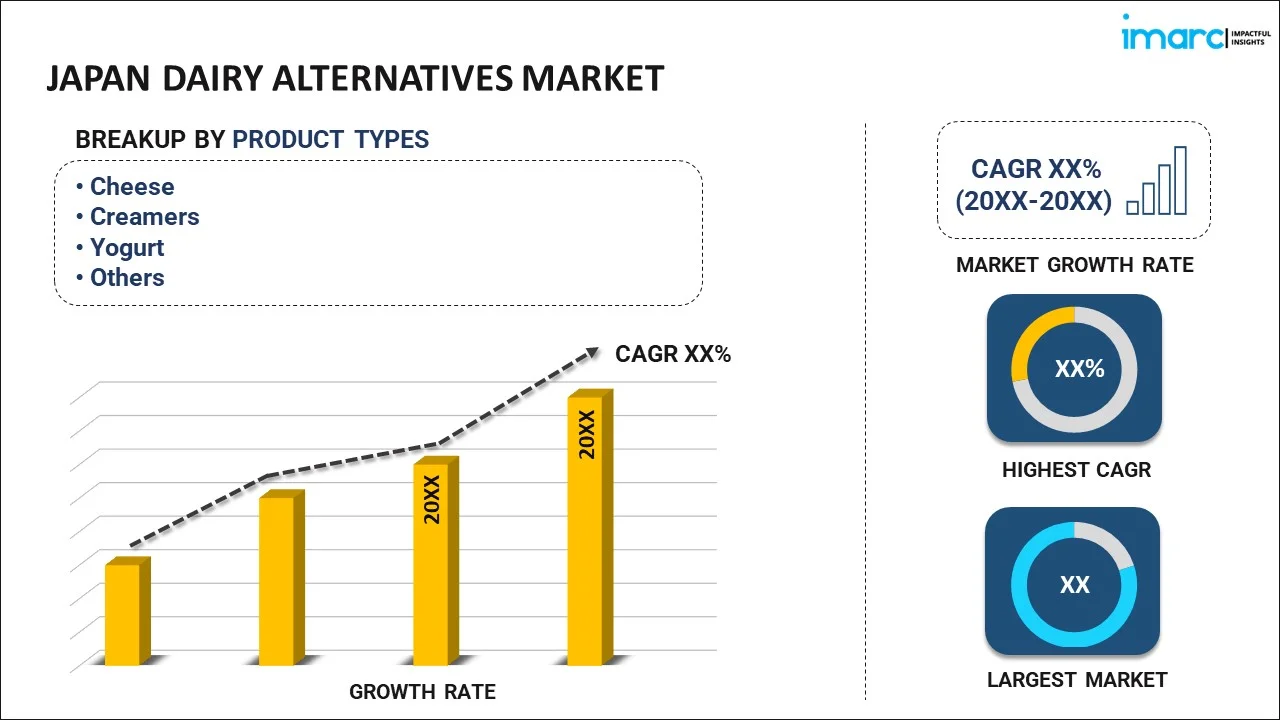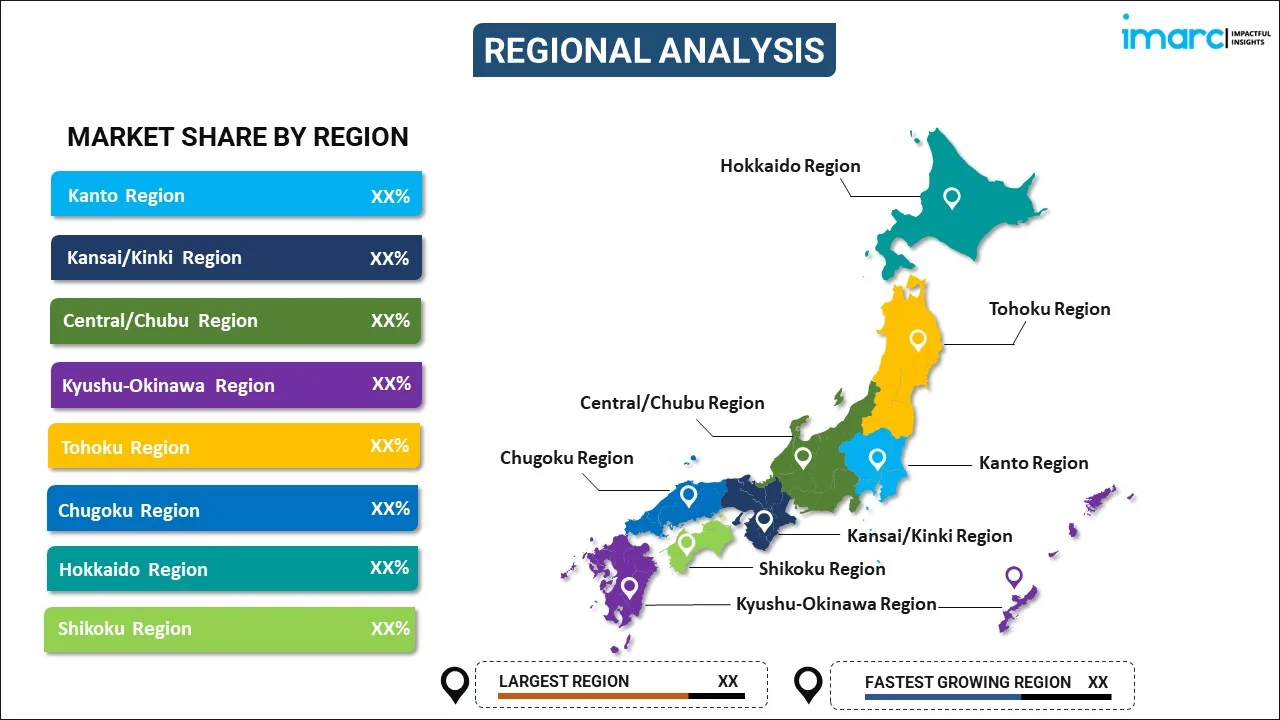
Japan Dairy Alternatives Market Report by Product Type (Cheese, Creamers, Yogurt, Ice Creams, Milk, and Others), Source (Almond, Soy, Oats, Hemp, Coconut, Rice, and Others), Formulation Type (Plain, Flavored), Nutrient (Protein, Starch, Vitamin, and Others), Distribution Channel (Supermarkets and Hypermarkets, Convenience Stores, Online Stores, and Others), and Region 2025-2033
Market Overview:
Japan dairy alternatives market size reached USD 1.6 Billion in 2024. Looking forward, IMARC Group expects the market to reach USD 3.0 Billion by 2033, exhibiting a growth rate (CAGR) of 6.75% during 2025-2033. The market is being propelled by several crucial factors, including the convenient accessibility of non-dairy alternatives through organized offline and online distribution channels and the increasing awareness of health and wellness among individuals.
|
Report Attribute
|
Key Statistics
|
|---|---|
|
Base Year
|
2024 |
|
Forecast Years
|
2025-2033 |
|
Historical Years
|
2019-2024
|
| Market Size in 2024 | USD 1.6 Billion |
| Market Forecast in 2033 | USD 3.0 Billion |
| Market Growth Rate (2025-2033) | 6.75% |
A dairy alternatives are food products designed primarily as substitutes for traditional dairy items, including milk, cheese, and yogurt. These alternatives are garnering increased favor among consumers who are lactose intolerant, follow a vegan diet, or prefer plant-based food choices. They offer various health advantages, such as lower calories, fat, and cholesterol content compared to conventional dairy products. Additionally, they serve as a valuable source of essential nutrients like calcium, vitamin D, and protein, contributing to the promotion of healthy weight management in individuals. Soy milk, almond milk, rice milk, coconut milk, oat milk, and cashew milk are among the most commonly favored dairy alternatives among consumers. These plant-derived products are often fortified with vitamins and minerals to provide a nutritional profile comparable to that of dairy products. As a result of heightened consumer awareness regarding their widespread availability, there has been a notable increase in the demand for dairy alternatives.
Japan Dairy Alternatives Market Trends:
The Japan dairy alternatives market is primarily propelled by the surging health consciousness prevalent among the population. This trend, accompanied by a growing inclination towards maintaining a health-conscious lifestyle and shifting dietary preferences, particularly among individuals adhering to vegan diets, is significantly bolstering the market. Concurrently, the increasing prevalence of lactose intolerance and allergies among consumers is contributing to a positive market outlook. Notably, several key market players are making substantial investments in continuous product innovations and development initiatives to meet the evolving consumer demands, thereby fortifying their market position and positively impacting market growth. Furthermore, the easy accessibility of dairy alternatives through organized offline and online distribution channels, alongside the emergence of efficient home delivery models, is significantly supporting the demand for dairy alternatives across Japan. Moreover, continuous advancements in production processes are serving as key factors propelling market growth. The market is further driven by heightened expenditure on aggressive marketing strategies, celebrity endorsements, innovative packaging solutions, and promotional campaigns. Other contributing factors include rapid urbanization, the proliferation of chain restaurants and quick-service eateries, and the simultaneous rise in disposable income levels among the populace, all of which are exerting a positive influence on market growth within Japan.
Japan Dairy Alternatives Market Segmentation:
IMARC Group provides an analysis of the key trends in each segment of the market, along with forecasts at the country level for 2025-2033. Our report has categorized the market based on product type, source, formulation type, nutrient, and distribution channel.
Product Type Insights:

- Cheese
- Creamers
- Yogurt
- Ice Creams
- Milk
- Others
The report has provided a detailed breakup and analysis of the market based on the product type. This includes cheese, creamers, yogurt, ice creams, milk, and others.
Source Insights:
- Almond
- Soy
- Oats
- Hemp
- Coconut
- Rice
- Others
A detailed breakup and analysis of the market based on the source have also been provided in the report. This includes almond, soy, oats, hemp, coconut, rice, and others.
Formulation Type Insights:
- Plain
- Sweetened
- Unsweetened
- Flavored
- Sweetened
- Unsweetened
The report has provided a detailed breakup and analysis of the market based on the formulation type. This includes plain (sweetened and unsweetened) and flavored (sweetened and unsweetened).
Nutrient Insights:
- Protein
- Starch
- Vitamin
- Others
A detailed breakup and analysis of the market based on the nutrient have also been provided in the report. This includes protein, starch, vitamin, and others.
Distribution Channel Insights:
- Supermarkets and Hypermarkets
- Convenience Stores
- Online Stores
- Others
The report has provided a detailed breakup and analysis of the market based on distribution channel. This includes supermarkets and hypermarkets, convenience stores, online stores, and others.
Regional Insights:

- Kanto Region
- Kansai/Kinki Region
- Central/ Chubu Region
- Kyushu-Okinawa Region
- Tohoku Region
- Chugoku Region
- Hokkaido Region
- Shikoku Region
The report has also provided a comprehensive analysis of all the major regional markets, which include Kanto Region, Kansai/Kinki Region, Central/ Chubu Region, Kyushu-Okinawa Region, Tohoku Region, Chugoku Region, Hokkaido Region, and Shikoku Region.
Competitive Landscape:
The market research report has also provided a comprehensive analysis of the competitive landscape. Competitive analysis such as market structure, key player positioning, top winning strategies, competitive dashboard, and company evaluation quadrant has been covered in the report. Also, detailed profiles of all major companies have been provided. Some of the key players include:
- Alpro
- Kikkoman Soy Foods Co. Ltd.
- Marusan-Ai Co. Ltd.
- Tsukuba Dairy Products Co. Ltd. (Shoei Foods Corp.)
(Please note that this is only a partial list of the key players, and the complete list is provided in the report.)
Japan Dairy Alternatives Market Report Coverage:
| Report Features | Details |
|---|---|
| Base Year of the Analysis | 2024 |
| Historical Period | 2019-2024 |
| Forecast Period | 2025-2033 |
| Units | Billion USD |
| Scope of the Report | Exploration of Historical Trends and Market Outlook, Industry Catalysts and Challenges, Segment-Wise Historical and Future Market Assessment:
|
| Product Types Covered | Cheese, Creamers, Yogurt, Ice Creams, Milk, Others |
| Sources Covered | Almond, Soy, Oats, Hemp, Coconut, Rice, Others |
| Formulation Types Covered |
|
| Nutrients Covered | Protein, Starch, Vitamin, Others |
| Distribution Channels Covered | Supermarkets and Hypermarkets, Convenience Stores, Online Stores, Others |
| Regions Covered | Kanto Region, Kansai/Kinki Region, Central/ Chubu Region, Kyushu-Okinawa Region, Tohoku Region, Chugoku Region, Hokkaido Region, Shikoku Region |
| Companies Covered | Alpro, Kikkoman Soy Foods Co. Ltd., Marusan-Ai Co. Ltd., Tsukuba Dairy Products Co. Ltd. (Shoei Foods Corp.), etc. |
| Customization Scope | 10% Free Customization |
| Post-Sale Analyst Support | 10-12 Weeks |
| Delivery Format | PDF and Excel through Email (We can also provide the editable version of the report in PPT/Word format on special request) |
Key Questions Answered in This Report:
- How has the Japan dairy alternatives market performed so far and how will it perform in the coming years?
- What has been the impact of COVID-19 on the Japan dairy alternatives market?
- What is the breakup of the Japan dairy alternatives market on the basis of product type?
- What is the breakup of the Japan dairy alternatives market on the basis of source?
- What is the breakup of the Japan dairy alternatives market on the basis of formulation type?
- What is the breakup of the Japan dairy alternatives market on the basis of nutrient?
- What is the breakup of the Japan dairy alternatives market on the basis of distribution channel?
- What are the various stages in the value chain of the Japan dairy alternatives market?
- What are the key driving factors and challenges in the Japan dairy alternatives?
- What is the structure of the Japan dairy alternatives market and who are the key players?
- What is the degree of competition in the Japan dairy alternatives market?
Key Benefits for Stakeholders:
- IMARC’s industry report offers a comprehensive quantitative analysis of various market segments, historical and current market trends, market forecasts, and dynamics of the Japan dairy alternatives market from 2019-2033.
- The research report provides the latest information on the market drivers, challenges, and opportunities in the Japan dairy alternatives market.
- Porter's five forces analysis assist stakeholders in assessing the impact of new entrants, competitive rivalry, supplier power, buyer power, and the threat of substitution. It helps stakeholders to analyze the level of competition within the Japan dairy alternatives industry and its attractiveness.
- Competitive landscape allows stakeholders to understand their competitive environment and provides an insight into the current positions of key players in the market.
Need more help?
- Speak to our experienced analysts for insights on the current market scenarios.
- Include additional segments and countries to customize the report as per your requirement.
- Gain an unparalleled competitive advantage in your domain by understanding how to utilize the report and positively impacting your operations and revenue.
- For further assistance, please connect with our analysts.
 Inquire Before Buying
Inquire Before Buying
 Speak to an Analyst
Speak to an Analyst
 Request Brochure
Request Brochure
 Request Customization
Request Customization




.webp)




.webp)












